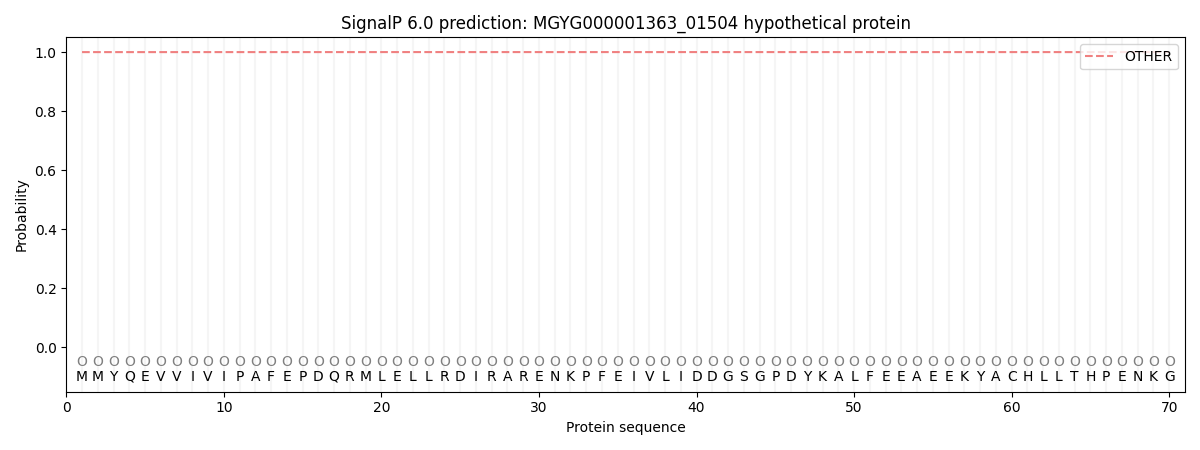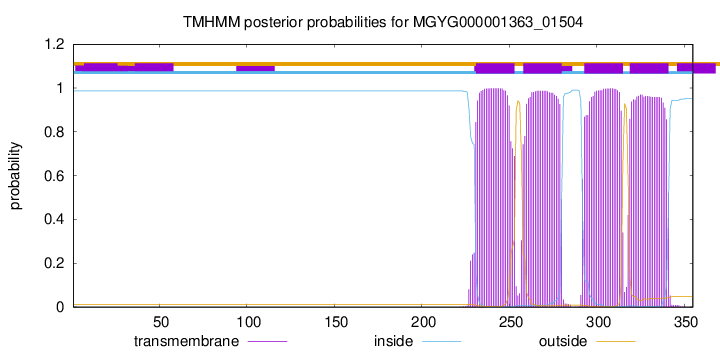You are browsing environment: HUMAN GUT
CAZyme Information: MGYG000001363_01504
You are here: Home > Sequence: MGYG000001363_01504
Basic Information |
Genomic context |
Full Sequence |
Enzyme annotations |
CAZy signature domains |
CDD domains |
CAZyme hits |
PDB hits |
Swiss-Prot hits |
SignalP and Lipop annotations |
TMHMM annotations
Basic Information help
| Species | Streptococcus equinus | |||||||||||
|---|---|---|---|---|---|---|---|---|---|---|---|---|
| Lineage | Bacteria; Firmicutes; Bacilli; Lactobacillales; Streptococcaceae; Streptococcus; Streptococcus equinus | |||||||||||
| CAZyme ID | MGYG000001363_01504 | |||||||||||
| CAZy Family | GT2 | |||||||||||
| CAZyme Description | hypothetical protein | |||||||||||
| CAZyme Property |
|
|||||||||||
| Genome Property |
|
|||||||||||
| Gene Location | Start: 79983; End: 81050 Strand: - | |||||||||||
CAZyme Signature Domains help
| Family | Start | End | Evalue | family coverage |
|---|---|---|---|---|
| GT2 | 8 | 136 | 2.2e-19 | 0.7352941176470589 |
CDD Domains download full data without filtering help
| Cdd ID | Domain | E-Value | qStart | qEnd | sStart | sEnd | Domain Description |
|---|---|---|---|---|---|---|---|
| cd04179 | DPM_DPG-synthase_like | 5.67e-33 | 8 | 190 | 1 | 185 | DPM_DPG-synthase_like is a member of the Glycosyltransferase 2 superfamily. DPM1 is the catalytic subunit of eukaryotic dolichol-phosphate mannose (DPM) synthase. DPM synthase is required for synthesis of the glycosylphosphatidylinositol (GPI) anchor, N-glycan precursor, protein O-mannose, and C-mannose. In higher eukaryotes,the enzyme has three subunits, DPM1, DPM2 and DPM3. DPM is synthesized from dolichol phosphate and GDP-Man on the cytosolic surface of the ER membrane by DPM synthase and then is flipped onto the luminal side and used as a donor substrate. In lower eukaryotes, such as Saccharomyces cerevisiae and Trypanosoma brucei, DPM synthase consists of a single component (Dpm1p and TbDpm1, respectively) that possesses one predicted transmembrane region near the C terminus for anchoring to the ER membrane. In contrast, the Dpm1 homologues of higher eukaryotes, namely fission yeast, fungi, and animals, have no transmembrane region, suggesting the existence of adapter molecules for membrane anchoring. This family also includes bacteria and archaea DPM1_like enzymes. However, the enzyme structure and mechanism of function are not well understood. The UDP-glucose:dolichyl-phosphate glucosyltransferase (DPG_synthase) is a transmembrane-bound enzyme of the endoplasmic reticulum involved in protein N-linked glycosylation. This enzyme catalyzes the transfer of glucose from UDP-glucose to dolichyl phosphate. This protein family belongs to Glycosyltransferase 2 superfamily. |
| pfam00535 | Glycos_transf_2 | 2.10e-16 | 8 | 125 | 2 | 115 | Glycosyl transferase family 2. Diverse family, transferring sugar from UDP-glucose, UDP-N-acetyl- galactosamine, GDP-mannose or CDP-abequose, to a range of substrates including cellulose, dolichol phosphate and teichoic acids. |
| cd06442 | DPM1_like | 1.34e-14 | 8 | 202 | 1 | 197 | DPM1_like represents putative enzymes similar to eukaryotic DPM1. Proteins similar to eukaryotic DPM1, including enzymes from bacteria and archaea; DPM1 is the catalytic subunit of eukaryotic dolichol-phosphate mannose (DPM) synthase. DPM synthase is required for synthesis of the glycosylphosphatidylinositol (GPI) anchor, N-glycan precursor, protein O-mannose, and C-mannose. In higher eukaryotes,the enzyme has three subunits, DPM1, DPM2 and DPM3. DPM is synthesized from dolichol phosphate and GDP-Man on the cytosolic surface of the ER membrane by DPM synthase and then is flipped onto the luminal side and used as a donor substrate. In lower eukaryotes, such as Saccharomyces cerevisiae and Trypanosoma brucei, DPM synthase consists of a single component (Dpm1p and TbDpm1, respectively) that possesses one predicted transmembrane region near the C terminus for anchoring to the ER membrane. In contrast, the Dpm1 homologues of higher eukaryotes, namely fission yeast, fungi, and animals, have no transmembrane region, suggesting the existence of adapter molecules for membrane anchoring. This family also includes bacteria and archaea DPM1_like enzymes. However, the enzyme structure and mechanism of function are not well understood. This protein family belongs to Glycosyltransferase 2 superfamily. |
| cd04188 | DPG_synthase | 3.44e-14 | 8 | 202 | 1 | 202 | DPG_synthase is involved in protein N-linked glycosylation. UDP-glucose:dolichyl-phosphate glucosyltransferase (DPG_synthase) is a transmembrane-bound enzyme of the endoplasmic reticulum involved in protein N-linked glycosylation. This enzyme catalyzes the transfer of glucose from UDP-glucose to dolichyl phosphate. |
| pfam04138 | GtrA | 1.42e-11 | 230 | 347 | 1 | 117 | GtrA-like protein. Members of this family are predicted to be integral membrane proteins with three or four transmembrane spans. They are involved in the synthesis of cell surface polysaccharides. The GtrA family are a subset of this family. GtrA is predicted to be an integral membrane protein with 4 transmembrane spans. It is involved is in O antigen modification by Shigella flexneri bacteriophage X (SfX), but does not determine the specificity of glucosylation. Its function remains unknown, but it may play a role in translocation of undecaprenyl phosphate linked glucose (UndP-Glc) across the cytoplasmic membrane. Another member of this family is a DTDP-glucose-4-keto-6-deoxy-D-glucose reductase, which catalyzes the conversion of dTDP-4-keto-6-deoxy-D-glucose to dTDP-D-fucose, which is involved in the biosynthesis of the serotype-specific polysaccharide antigen of Actinobacillus actinomycetemcomitans Y4 (serotype b). This family also includes the teichoic acid glycosylation protein, GtcA, which is a serotype-specific protein in some Listeria innocua and monocytogenes strains. Its exact function is not known, but it is essential for decoration of cell wall teichoic acids with glucose and galactose. |
CAZyme Hits help
| Hit ID | E-Value | Query Start | Query End | Hit Start | Hit End |
|---|---|---|---|---|---|
| VEE21329.1 | 1.31e-228 | 1 | 355 | 1 | 355 |
| QMS96753.1 | 1.39e-223 | 1 | 355 | 1 | 355 |
| QGX46459.1 | 2.38e-208 | 1 | 355 | 1 | 355 |
| QGZ26731.1 | 2.38e-208 | 1 | 355 | 1 | 355 |
| SQG78701.1 | 1.98e-179 | 1 | 353 | 1 | 353 |
Swiss-Prot Hits download full data without filtering help
| Hit ID | E-Value | Query Start | Query End | Hit Start | Hit End | Description |
|---|---|---|---|---|---|---|
| Q58619 | 3.20e-20 | 5 | 230 | 18 | 236 | Uncharacterized protein MJ1222 OS=Methanocaldococcus jannaschii (strain ATCC 43067 / DSM 2661 / JAL-1 / JCM 10045 / NBRC 100440) OX=243232 GN=MJ1222 PE=4 SV=1 |
| B3VA58 | 2.85e-14 | 8 | 208 | 8 | 222 | UDP-N-acetylglucosamine--dolichyl-phosphate N-acetylglucosaminyltransferase OS=Methanococcus voltae OX=2188 GN=aglK PE=1 SV=1 |
SignalP and Lipop Annotations help
This protein is predicted as OTHER

| Other | SP_Sec_SPI | LIPO_Sec_SPII | TAT_Tat_SPI | TATLIP_Sec_SPII | PILIN_Sec_SPIII |
|---|---|---|---|---|---|
| 1.000048 | 0.000000 | 0.000000 | 0.000000 | 0.000000 | 0.000000 |
TMHMM Annotations download full data without filtering help

| start | end |
|---|---|
| 231 | 253 |
| 258 | 280 |
| 293 | 315 |
| 319 | 341 |
